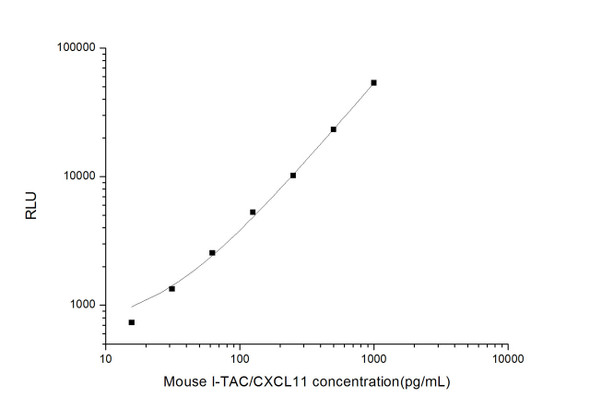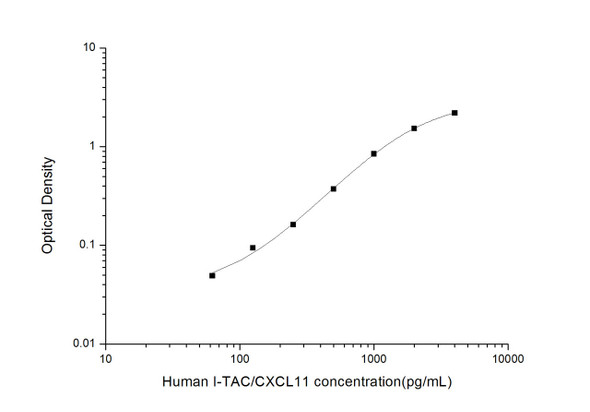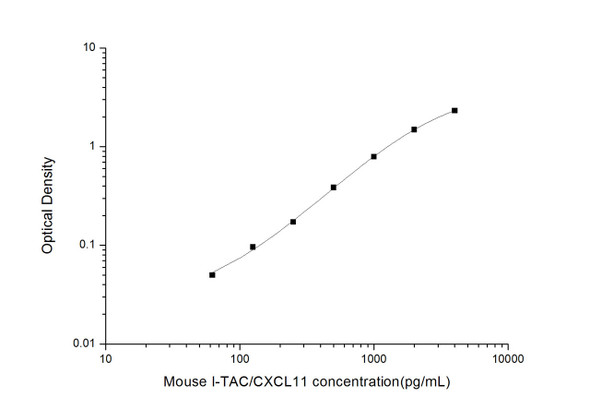Human Cell Biology ELISA Kits 3
Human I-TAC (Interferon Inducible T-cell Alpha Chemoattractant) CLIA Kit (HUES00049)
- SKU:
- HUES00049
- Product Type:
- ELISA Kit
- ELISA Type:
- CLIA Kit
- Size:
- 96 Assays
- Sensitivity:
- 9.38pg/mL
- Range:
- 15.63-1000pg/mL
- ELISA Type:
- Sandwich
- Synonyms:
- CXCL11, H174, IP-9, IP9, SCYB11, SCYB9B, b-R1
- Reactivity:
- Human
- Sample Type:
- Serum, plasma and other biological fluids
- Research Area:
- Cell Biology
Description
| Assay type: | Sandwich |
| Format: | 96T |
| Assay time: | 4.5h |
| Reactivity: | Human |
| Detection method: | Chemiluminescence |
| Detection range: | 15.63-1000 pg/mL |
| Sensitivity: | 9.38 pg/mL |
| Sample volume: | 100µL |
| Sample type: | Serum, plasma and other biological fluids |
| Repeatability: | CV < 15% |
| Specificity: | This kit recognizes Human I-TAC in samples. No significant cross-reactivity or interference between Human I-TAC and analogues was observed. |
This kit uses Sandwich-CLIA as the method. The micro CLIA plate provided in this kit has been pre-coated with an antibody specific to Human I-TAC. Standards or samples are added to the appropriate micro CLIA plate wells and combined with the specific antibody. Then a biotinylated detection antibody specific for Human I-TAC and Avidin-Horseradish Peroxidase (HRP) conjugate are added to each micro plate well successively and incubated. Free components are washed away. The substrate solution is added to each well. Only those wells that contain Human I-TAC, biotinylated detection antibody and Avidin-HRP conjugate will appear fluorescence. The Relative light unit (RLU) value is measured spectrophotometrically by the Chemiluminescence immunoassay analyzer. The RLU value is positively associated with the concentration of Human I-TAC. The concentration of Human I-TAC in the samples can be calculated by comparing the RLU of the samples to the standard curve.
| UniProt Protein Function: | CXCL11: Chemotactic for interleukin-activated T-cells but not unstimulated T-cells, neutrophils or monocytes. Induces calcium release in activated T-cells. Binds to CXCR3. May play an important role in CNS diseases which involve T-cell recruitment. May play a role in skin immune responses. Belongs to the intercrine alpha (chemokine CxC) family. |
| UniProt Protein Details: | Protein type:Motility/polarity/chemotaxis; Chemokine; Secreted; Secreted, signal peptide Chromosomal Location of Human Ortholog: 4q21. 2 Cellular Component: extracellular space; extracellular region Molecular Function:heparin binding; protein binding; CXCR3 chemokine receptor binding; chemokine activity Biological Process: G-protein coupled receptor protein signaling pathway; cell-cell signaling; immune response; positive regulation of leukocyte chemotaxis; response to lipopolysaccharide; positive regulation of release of sequestered calcium ion into cytosol; positive regulation of cAMP metabolic process; signal transduction; chemotaxis; inflammatory response; regulation of cell proliferation |
| NCBI Summary: | Chemokines are a group of small (approximately 8 to 14 kD), mostly basic, structurally related molecules that regulate cell trafficking of various types of leukocytes through interactions with a subset of 7-transmembrane, G protein-coupled receptors. Chemokines also play fundamental roles in the development, homeostasis, and function of the immune system, and they have effects on cells of the central nervous system as well as on endothelial cells involved in angiogenesis or angiostasis. Chemokines are divided into 2 major subfamilies, CXC and CC. This antimicrobial gene is a CXC member of the chemokine superfamily. Its encoded protein induces a chemotactic response in activated T-cells and is the dominant ligand for CXC receptor-3. The gene encoding this protein contains 4 exons and at least three polyadenylation signals which might reflect cell-specific regulation of expression. IFN-gamma is a potent inducer of transcription of this gene. Two transcript variants encoding different isoforms have been found for this gene. [provided by RefSeq, Oct 2014] |
| UniProt Code: | O14625 |
| NCBI GenInfo Identifier: | 7674360 |
| NCBI Gene ID: | 6373 |
| NCBI Accession: | O14625. 1 |
| UniProt Related Accession: | O14625 |
| Molecular Weight: | |
| NCBI Full Name: | C-X-C motif chemokine 11 |
| NCBI Synonym Full Names: | C-X-C motif chemokine ligand 11 |
| NCBI Official Symbol: | CXCL11 |
| NCBI Official Synonym Symbols: | IP9; H174; IP-9; b-R1; I-TAC; SCYB11; SCYB9B |
| NCBI Protein Information: | C-X-C motif chemokine 11 |
| UniProt Protein Name: | C-X-C motif chemokine 11 |
| UniProt Synonym Protein Names: | Beta-R1; H174; Interferon gamma-inducible protein 9; IP-9; Interferon-inducible T-cell alpha chemoattractant; I-TAC; Small-inducible cytokine B11 |
| UniProt Gene Name: | CXCL11 |
| UniProt Entry Name: | CXL11_HUMAN |
As the RLU values of the standard curve may vary according to the conditions of the actual assay performance (e. g. operator, pipetting technique, washing technique or temperature effects), the operator should establish a standard curve for each test. Typical standard curve and data is provided below for reference only.
| Concentration (pg/mL) | RLU | Average | Corrected |
| 1000 | 51754 55596 | 53675 | 53650 |
| 500 | 21337 23641 | 22489 | 22464 |
| 250 | 10866 9556 | 10211 | 10186 |
| 125 | 4648 5154 | 4901 | 4876 |
| 62.5 | 2640 2266 | 2453 | 2428 |
| 31.25 | 1292 1270 | 1281 | 1256 |
| 15.63 | 689 727 | 708 | 683 |
| 0 | 24 26 | 25 | -- |
Precision
Intra-assay Precision (Precision within an assay): 3 samples with low, mid range and high level Human I-TAC were tested 20 times on one plate, respectively.
Inter-assay Precision (Precision between assays): 3 samples with low, mid range and high level Human I-TAC were tested on 3 different plates, 20 replicates in each plate.
| Intra-assay Precision | Inter-assay Precision | |||||
| Sample | 1 | 2 | 3 | 1 | 2 | 3 |
| n | 20 | 20 | 20 | 20 | 20 | 20 |
| Mean (pg/mL) | 51.41 | 115.32 | 466.51 | 55.92 | 108.70 | 461.95 |
| Standard deviation | 6.22 | 12.56 | 48.24 | 5.70 | 8.19 | 29.93 |
| C V (%) | 12.10 | 10.89 | 10.34 | 10.19 | 7.53 | 6.48 |
Recovery
The recovery of Human I-TAC spiked at three different levels in samples throughout the range of the assay was evaluated in various matrices.
| Sample Type | Range (%) | Average Recovery (%) |
| Serum (n=5) | 98-112 | 105 |
| EDTA plasma (n=5) | 87-99 | 94 |
| Cell culture media (n=5) | 96-111 | 104 |
Linearity
Samples were spiked with high concentrations of Human I-TAC and diluted with Reference Standard & Sample Diluent to produce samples with values within the range of the assay.
| Serum (n=5) | EDTA plasma (n=5) | Cell culture media (n=5) | ||
| 1:2 | Range (%) | 97-112 | 87-98 | 86-103 |
| Average (%) | 105 | 92 | 94 | |
| 1:4 | Range (%) | 90-103 | 93-107 | 91-102 |
| Average (%) | 95 | 98 | 96 | |
| 1:8 | Range (%) | 99-116 | 96-113 | 87-99 |
| Average (%) | 106 | 103 | 92 | |
| 1:16 | Range (%) | 87-99 | 95-111 | 101-114 |
| Average (%) | 93 | 102 | 108 |
An unopened kit can be stored at 4°C for 1 month. If the kit is not used within 1 month, store the items separately according to the following conditions once the kit is received.
| Item | Specifications | Storage |
| Micro CLIA Plate(Dismountable) | 8 wells ×12 strips | -20°C, 6 months |
| Reference Standard | 2 vials | |
| Concentrated Biotinylated Detection Ab (100×) | 1 vial, 120 µL | |
| Concentrated HRP Conjugate (100×) | 1 vial, 120 µL | -20°C(shading light), 6 months |
| Reference Standard & Sample Diluent | 1 vial, 20 mL | 4°C, 6 months |
| Biotinylated Detection Ab Diluent | 1 vial, 14 mL | |
| HRP Conjugate Diluent | 1 vial, 14 mL | |
| Concentrated Wash Buffer (25×) | 1 vial, 30 mL | |
| Substrate Reagent A | 1 vial, 5 mL | 4°C (shading light) |
| Substrate Reagent B | 1 vial, 5 mL | 4°C (shading light) |
| Plate Sealer | 5 pieces | |
| Product Description | 1 copy | |
| Certificate of Analysis | 1 copy |
- Set standard, test sample and control (zero) wells on the pre-coated plate and record theirpositions. It is recommended to measure each standard and sample in duplicate. Note: addall solutions to the bottom of the plate wells while avoiding contact with the well walls. Ensuresolutions do not foam when adding to the wells.
- Aliquot 100µl of standard solutions into the standard wells.
- Add 100µl of Sample / Standard dilution buffer into the control (zero) well.
- Add 100µl of properly diluted sample (serum, plasma, tissue homogenates and otherbiological fluids. ) into test sample wells.
- Cover the plate with the sealer provided in the kit and incubate for 90 min at 37°C.
- Aspirate the liquid from each well, do not wash. Immediately add 100µL of BiotinylatedDetection Ab working solution to each well. Cover the plate with a plate seal and gently mix. Incubate for 1 hour at 37°C.
- Aspirate or decant the solution from the plate and add 350µL of wash buffer to each welland incubate for 1-2 minutes at room temperature. Aspirate the solution from each well andclap the plate on absorbent filter paper to dry. Repeat this process 3 times. Note: a microplatewasher can be used in this step and other wash steps.
- Add 100µL of HRP Conjugate working solution to each well. Cover with a plate seal andincubate for 30 min at 37°C.
- Aspirate or decant the solution from each well. Repeat the wash process for five times asconducted in step 7.
- Add 100µL of Substrate mixture solution to each well. Cover with a new plate seal andincubate for no more than 5 min at 37°C. Protect the plate from light.
- Determine the RLU value of each well immediately.






